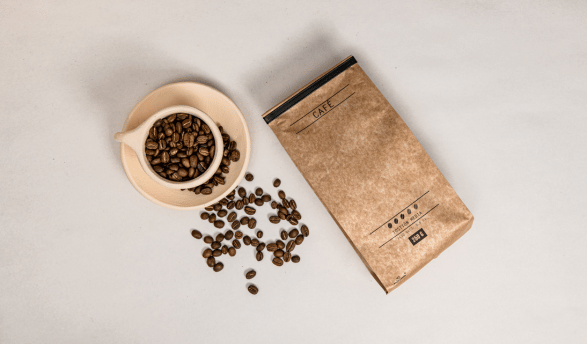A compostable coffee bag packaging that works ? Don't hold your breath.
Date Posted:17 January 2024

It felt like a lifetime ago when we started applying pressure on our coffee bag supplier for a greener option.
Back in 2014, the choice of materials was limited, and so was the level of innovation. Innovation was a dirty word in the coffee packaging industry, except for the changes from glossy to matt finishes. It was as exciting as watching paint dry or waiting outside for my wife to "browse inside" a shop - I'll just be a quick minute luv.
Why change?
Perhaps a touch of gas lighting by the manufacturers. In their mind, there was nothing wrong with the status quo. Of course, there are vested interests in keeping things the same as the machinery or equipment required to make coffee bags is complex and expensive.
Bag makers are isolated from their product's end users. Instead, it passes through many hands, from exporter to importer, to roaster to retailer, and then to the consumer.
If there is any pressure from consumers for change, then bag makers won't feel it. What burning platform?
In the last decade, much of the effort around innovation has occurred in areas involving the changes in form factor and physical footprint of retail bags. These include moving from stand-up pouches to box-bottom so they take up less shelf space. There has also been that move from irritating zip locks to even more irritating rippa-zippas, both being utterly useless and nuisance gimmicks that fail to keep coffee fresh, besides wasting much more harmful plastic.
Some bag makers also took sneaky steps to stealthily replace critical foil layers with a metalized polyester alternative to save costs and improve the flexibility and durability level of the materials. A soft bag is a nice bag, they say. No, it's most certainly not if the performance drops and the cost doesn't.
To fully appreciate the challenges of creating a solution for packaging freshly roasted coffee, it is useful to understand that coffee is one of the most complex and demanding food ingredients.
As a highly volatile product that continues to change and transform well after it has been processed or roasted, coffee emits a significant level of CO2, and this continues for up to 14 days (or longer in colder climate) after the roast, subject to conditions such as temperature and roast profile.
In other words, freshly roasted coffee is still "alive"; ground coffee is basically "trying to jump to the moon" for a short time after grinding.
Trapping this essential volatility is one of the many key priorities of coffee packaging. Locking in the desirable features while simultaneously trying to slow down the unstoppable degradation of the product quality.
But it's more complex. You may think using an oxygen seal will provide an effective barrier. Volatiles in freshly roasted coffees leach through most plastics and other materials via effusion.
Only metalized foils can create a suitable barrier for freshly roasted coffees.
However, foils are hard to work with and expensive, so an extra layer or two is needed to make a durable, flexible, and reliable packaging product.
That is how coffee bags are constructed, by using three distinct layers.
The inner layer is a food-grade resin protecting the safety and purity of the ingredients, the middle layer consists of metalized foil as a critical freshness barrier, and the outer layer is another resin for cosmetic appreciation.
One could argue that we should try to eliminate the outer layer, but then rarely will consumers purchase an "ugly" or ratty-looking product.
Another critical component for roasted coffee bags is the 1-way valve. This valve allows the pressure of CO2 emitted from the roasted coffee to slowly exhaust without allowing oxygen to re-enter. Bags without valves risk exploding or bursting, especially under warmer conditions.
These valves are not cheap, and if you see bags without valves, it could be that the coffee was pre-staled, "degassed", or the materials used in the construction of the bag do not contain a metalized barrier layer, so the bag "breathes". That is not a good solution as it accelerates the deterioration of the roasted coffee via oxidization.
Coffee bags are expensive and complex. They are also not made in Australia.
Even though we have been buying bags for 17 years, we still see problems in the manufacturing from time to time - it could be a minor chemical odour residue from incorrect curing, a valve or its misaligned perforations preventing the function or the seals that randomly fail by un-bonding.
For these reasons, we will only source from the best quality Australian suppliers instead of running the risks of importing from overseas to save money. We know of coffee brands stranded with 200,000 defective bags. Our bags must survive the torture of rough handling in the parcel freight networks.
Let's get back to how to might transition to a more environmentally friendly packaging solution.
Compostable bags - made from recycled brown paper with a plant-based biofilm (PLA)- were some of the early generations of eco-packaging released to the market. They came with a loosely applied caveat rarely announced or explicitly available to the end customer, such as "contents recommended for immediate consumption" or "transfer into another container".
No one defined a proper standard or specification, and it was left to roasting companies to develop their guidelines based on inaccurate science or gut feeling.
Over time, whilst compostable equivalents have improved in terms of performance, they are still a long way from meeting the rigorous performance outcomes generated by conventional bags.
All the eco bags are still suffering from the same set of challenges - heat and moisture affect the packaging materials, they are not "airtight", and for applications like freshly roasted coffee, they can result in a staling of the product at rates of 5x to 15x faster than comparable 3-layer metalized bag.
As the coffee industry is a competitive war zone, some brands could see the opportunity to get a leg up on everyone else by marketing their "green credentials" aggressively without sufficient transparency to the buyer in declaring that their bags were not able to keep the coffee fresh for any given period.
Most coffee drinkers are unaware of the rapid timeframes that freshly roasted coffee declines in quality and often believe that if the product is still in a sealed bag, then it's the same freshness as when they bought it. Unfortunately, this is not the case.
Heat is also a key factor in retarding the impact of oxidization for freshly roasted coffee. Not only does the metalized layer on a conventional bag provide essential barrier protection, but it also offers greater thermal insulation and UV blocking.
Today, most coffee brands maintain an "arms-length" relationship with compostable coffee bags to retain a useful halo that keeps punters engaged or interested. The truth is, none of us wants our precious coffees in those eco bags - yet.
Why?
Simples. The packaging spoils all the hard work and effort to make a great coffee, compromising quality. It's like painting a picture and then leaving it outside in the weather - not going to last the expected distance.
Then, recycling became the hottest topic in packaging, with brands scrambling to jump on the bandwagon. Made from 2 layers of low-density polyethylene (LDPE) and EVOH, these materials are intended for soft-plastic recycling by councils, yet many municipalities are still transitioning to segregated waste disposal or waging wars about what is allowed and what isn't.
It's only a guesstimate, but I reckon barely 50 per cent of Australian councils accept these eco products, with the remaining enforcing bans.
The performance of recyclable bags was also sub-standard compared to conventional metalized barrier materials.
Again, it's a case of roast, pack and consume immediately - hardly practical across the broad spectrum of coffee drinkers.
Customers tend to buy in 3+ kilo orders at intervals of monthly to bi-monthly. These bags will not represent our inherent product quality over that timeframe; hence, our integrity is at risk or compromised.
Australia's recycling programs are still a confusing mess after the collapse of the Recycle in June last year and the ongoing dilemma of how to sort out the accumulated waste and where to "send it", given many countries are now banning the receipt of another country's waste materials.
Other types of greener solutions are being trialled overseas for coffee packaging, such as rice paper bags made from renewable sources such as tree bark and bamboo. However, it's still in the early days, and the barrier protections mostly evolved from plant-based resins. Formulations that are constantly changing or evolving, often without sufficient testing data to back up claims (why is this not surprising in the realm of fast promises and zero consequences).
Home compostable is the end game for consumer ingredients packaging, and this has been an important requirement in single-use portion control coffees where packaging waste is disproportionately higher.
Yet there are still many different factors to consider.
Often, the materials perform differently than intended, or the performance could be highly inconsistent. There is also the risk of misunderstanding when consumers think an eco-material is compostable at home. Many compostable materials still require commercial composting at an industrial facility and it's this confusion which council waste divisions realize are leading to major mistakes.
Over the last few years, we have seen many brands market compostable packaging, yet the "small print" about it requiring commercial composting is often missed or overlooked at the time of disposal. Sometimes, we wonder if it was a genuine mistake or a convenient oversight.
We also think that definitions could be more specific and clear. Lazy brands market their products as "recyclable, compostable and biodegradable" all at the same time as a sneaky way to trap a sale, like fishing with a dragnet. Full bore appeal to the eco warriors.
Biodegradable and compostable are not the same thing. Biodegradables break down into water, CO2 and biomass without intervention. On the other hand, compostable is also biodegradable and breaks down under controlled conditions with some intervention over a 90-day or shorter timeframe.
The key difference is that compostable materials are supposed to add nutrients to the soil, but that is rarely the case for most types of compostable food packaging. In fact, literally none of them add nutrient value. Sometimes, the inks, labelling materials, or bonding resin cause further problems or possible contamination, especially the newer preparations which have been rushed to market without proper testing or analysis.
Bury enough compostable packaging in your garden, and the nutrient levels in the soil will plummet - a well proven fact.
Studies have found that compostable materials produce greater greenhouse gases than conventional materials buried in landfills. The methane and heat generated by compostable materials can be up to 30 times greater.
There have also been broader concerns that countries such as China have "secured and locked up" most of the global supply chains used for PLA-based resins, creating a monopoly position, raising costs, and exploiting markets, ironically not unlike batteries for electric vehicles.
Finally, the agricultural practices used to grow crops for biomaterials use dangerous chemical fertilizers and pesticides as the crop is not for human consumption. Water run-off and soils are rendered unproductive or contaminated in an astonishingly short period.
We can debate and argue forever, but the proof is in the pudding. To test our theories on the performance of eco-packaging for coffee, we tried a few experiments that involved purchasing competitor products packaged in eco-friendly materials.
Without naming brands, the coffee appeared devoid of any aroma, rather mild in taste and at times lifeless despite being only three weeks old (according to their packaging).
And it wasn't just a single brand; the results were strangely similar across our limited testing.
The roasted coffee tasted or behaved like it could have been at least two months old. Sure, we can't entirely blame the packaging, as other factors could have been at play.
But it does illustrate the critical problems coffee brands wrestle with constantly - trying to do good (or better) whilst also trying to survive in a difficult market with zero tolerance for mediocre product performance.
Meanwhile, back at the ranch we continue to receive a regular stream of random abuse, mostly from activist strangers who have never purchased our products previously, all claiming our company is destroying the planet by not using a green packaging alternative.
An then sometimes, although not often, it's really hard not to feel disappointed or frustrated when a an existing customer somehow gets a bee in their bonnet about packaging and feels the need to bully us about the absence of a workable eco-solution, often going off the deep end in a rant without understanding all the facts.
Of course, in a fantasy world all the freshly roasted coffee will never stale or degrade, it is easily packaged in 100% natural plant materials with zero impact upon the planet and there are less competitors fighting for a smaller segment of potential customers who always graciously and unconditionally accept coffee of any quality standard. Not hard to see the disconnect.
By 2024, we had hoped there would be some solid breakthroughs in eco-packaging for freshly roasted coffee, but it still seems to be waiting for that silver bullet.
Our packaging suppliers start every year with a positive and enthusiastic mission filled with hope of a miracle that new materials magically appear onto the scene, even to take the relentless pressure off their heavily shoulders. But just like Groundhog Day, we relive the same episode endlessly as we carefully watch and test. Same amazing promises, same sub-standard results.
Whilst it might seem like we are vigorously defending our position to stay with conventional packaging, it is irresponsible to ignore the many risks and significant issues related to changing an important feature in our solution. One slip and we are going to sink - that's how important the correct packaging system is for any freshly roasted coffee.
Well, it is if you care. Maybe some don't.
As soon as we are satisfied that the product meets a known performance standard, we will be the first to embrace it.
According to the packaging experts, they will quietly say "don't hold your breath".



